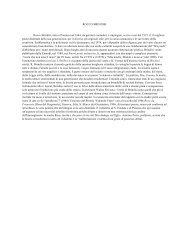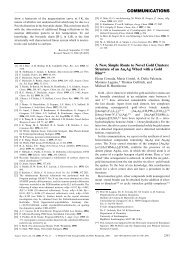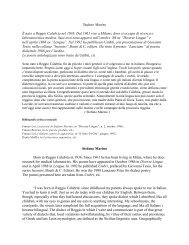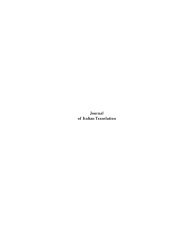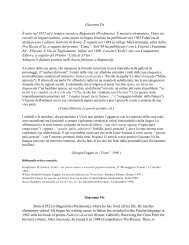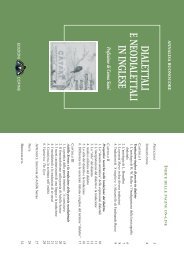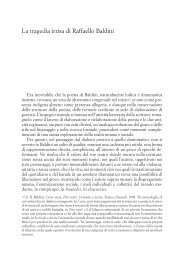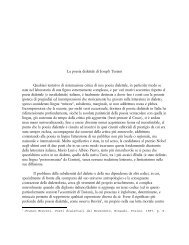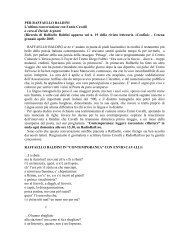Journal of Italian Translation
Journal of Italian Translation
Journal of Italian Translation
You also want an ePaper? Increase the reach of your titles
YUMPU automatically turns print PDFs into web optimized ePapers that Google loves.
Lina Insana/Primo Levi<br />
theatrical audience) to come to a conclusion based on the survivor’s “tale,”<br />
while in “Cromo” Levi’s focus is his urgent need to purify himself, to rid<br />
himself <strong>of</strong> the albatross hanging around his own neck through storytelling.<br />
Though these paraphrastic references to the Ancient Mariner character<br />
date to 1966, his explicit citation and translation <strong>of</strong> one specific four-verse<br />
stanza brought this affinity to its culmination in the last few years <strong>of</strong> his life,<br />
inspiring not only the 1984 poem “Il superstite,” but the title <strong>of</strong> its entire<br />
collection, Ad ora incerta (1984), and the incipit <strong>of</strong> his last book, I sommersi e i<br />
salvati (1986): “Since then, at an uncertain hour,/ That agony returns:/ And<br />
till my ghastly tale is told,/ This heart within me burns” (vv. 582-85). The<br />
consistency with which Levi returns to the Coleridge text and its protagonist<br />
challenges us to reckon with their importance as figures for Levi’s testimonial<br />
project. Moreover, Levi’s active mediation <strong>of</strong> his source text demands<br />
that this reckoning occur on the terrain <strong>of</strong> translation, both on the level <strong>of</strong><br />
theme (the citing, recoding and traumatic retelling that are central to<br />
Coleridge’s text), and on the formal level (the specific acts <strong>of</strong> citation and<br />
[mis] translation that occur within the textual space <strong>of</strong> Levi’s poem).<br />
“Il superstite”<br />
The first line <strong>of</strong> the <strong>of</strong>t-cited Coleridge passage (v. 582) is reproduced<br />
tale quale, as the first verse <strong>of</strong> Levi’s poem: “Since then, at an uncertain hour”.<br />
The second line is Levi’s translation <strong>of</strong> the first, faithfully done, and represented<br />
in regular type: “Dopo di allora, ad ora incerta.” This is followed in<br />
the third verse by a close translation <strong>of</strong> Coleridge’s next line (v. 583), “That<br />
agony returns” (“Quella pena ritorna”), and then a significantly altered<br />
rendering <strong>of</strong> the next two verses, to which we will soon return.<br />
Remarkably, despite critical unanimity regarding the role <strong>of</strong> the Fenoglio<br />
translation in familiarizing Levi with the poem, Levi’s translation <strong>of</strong> the<br />
verses from the “Rime” is clearly original. Fenoglio’s translation <strong>of</strong> vv. 582-<br />
85 reads: “Da quel momento, a un’ora imprecisa,/ Quell’agonia mi torna;/ E<br />
fino a che non ho detta la mia storia/ Di morti, dentro mi brucia il cuore.”<br />
Levi’s version, instead, reads: “Dopo di allora, ad ora incerta,/ Quella pena<br />
ritorna,/ E se non trova chi lo ascolti/ Gli brucia in petto il cuore.” Of particular<br />
note in a casual comparison between the source text and Fenoglio’s<br />
and Levi’s translation <strong>of</strong> it is the fact that the former’s addition <strong>of</strong> “Di morti”<br />
in verse 585—made, one assumes, to approximate Coleridge’s original<br />
tetrameter—does not materialize in Levi’s translation, leading us to believe<br />
that Levi was translating from Coleridge directly and not from Fenoglio’s<br />
1964 translation. As we shall soon see, Levi’s omission <strong>of</strong> Fenoglio’s unfaithful<br />
reference to death provides not only textual pro<strong>of</strong> <strong>of</strong> his direct relationship<br />
to the Coleridge source text, but also helps to interrogate ostensibly<br />
clear distinctions between life and death, “sommersi” and “salvati.”<br />
Starting with v. 6, Levi’s “Il superstite” then makes a transition from<br />
the Coleridge source text and his interpretation <strong>of</strong> it to a more properly “origi-<br />
25



